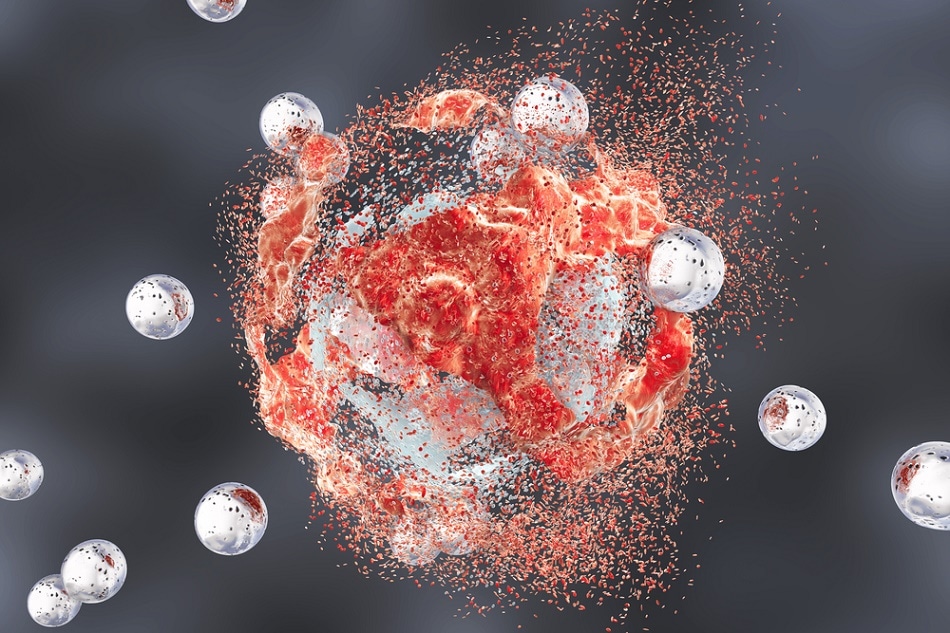Sep 29 2016
 Image Credit: Kateryna Kon/Shutterstock.com
Image Credit: Kateryna Kon/Shutterstock.com
Cornell dots or C dots are nanoparticles that are emerging as promising therapeutic tools to detect and treat cancer.
These nanoparticles were developed by Ulrich Wiesner, the Spencer T. Olin Professor of Engineering at Cornell University over 12 years ago. These ultrasmall particles have now proved that they are capable of killing cancer cells without linking a cytotoxic drug.
Michelle Bradbury, director of intraoperative imaging at Memorial Sloan Kettering Cancer Center and associate professor of radiology at Weill Cornell Medicine, and Michael Overholtzer, cell biologist at MSKCC headed the research endeavor, and collaborated with Wiesner. The study explains how a certain type of cell death known as ferroptosis is caused by C dots when the nanoparticles are administered in heavy doses, and the tumors experience nutrient deprivation.
If you had to design a nanoparticle for killing cancer, this would be exactly the way you would do it. The particle is well tolerated in normally healthy tissue, but as soon as you have a tumor, and under very specific conditions, these particles become killers.
Ulrich Wiesner, Professor, Cornell University
“In fact,” Bradbury said, “this is the first time we have shown that the particle has intrinsic therapeutic properties.”
Wiesner originally designed the small fluorescent silica particle that is 5 nm in diameter to be employed as diagnostic tools. They were meant to be attached to cancer cells and illuminate to indicate the place of the tumor cells to the surgeon. The potential use of these nanoparticles also included environment sensing and drug delivery. The particle was deemed to be safe for humans after a first-in-human clinical trial was conducted by the Food and Drug Administration.
The latest discovery was made in the past five years by Bradbury, Overholtzer, Wiesner and their collaborators, during further experiments.
Wiesner’s peptide-coated C dots exhibited the potential to absorb iron from the surroundings and carry this into the tumor cells, when they were incubated with cancer cells at increased doses, especially those in a state of nutrient deprivation. The peptide used in the experiment is known as alpha-MSH, and was developed by professor of biochemistry at the University of Missouri, Thomas Quinn.
This process results in a necrotic form of cell death known as ferroptosis, which involves plasma membrane rupture. This is unlike the usual cell fragmentation that takes place during apoptosis, a more common form of cell death.
The original purpose for studying the dots in cells was to see how well larger concentrations would be tolerated without altering cellular function. While high concentrations were well-tolerated under normal conditions, we wanted to also know how cancer cells under stress might respond.
Michael Overholtzer, Cell Biologist, MSKCC
Wiesner said that within 24 to 48 hours of exposure to the C dots, the entire cell culture was swept by an unexpected “wave of destruction.” Bradbury stated that the tumors shrank and no undesirable reaction were caused when mice were administered with numerous high dose injections.
Cancer kills millions of people worldwide, and having lost several family members to the disease, this research is a personal crusade for Wiesner. He stated that having another weapon against the disease can only help.
We’ve found another tool that people have not thought about at all so far. This has changed our way of thinking about nanoparticles and what they could potentially do.
Ulrich Wiesner, Professor, Cornell University
Bradbury stated that further research will focus on combining these particles with other regular therapies for a particular tumor type, with the hope of improving the efficacy before it is tested in humans. The scientists are also planning to customize the nanoparticle to target specific cancers.
The paper titled ‘Ultrasmall Nanoparticles Induce Ferroptosis of Nutrient-Deprived Cancer Cells and Suppress Tumor Growth,’ was featured in the September 26 issue of Nature Nanotechnology.